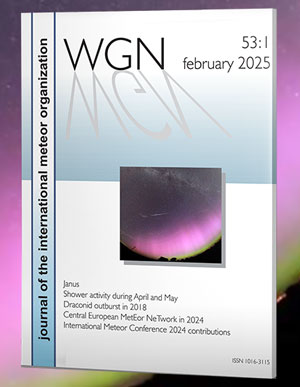During this period the moon waxes from its new phase to nearly fifty percent illuminated. This will limit moonlight to the evening hours during the first portion of this period and up to 2am by Friday May 17. The estimated total hourly meteor rates for evening observers this week is near two as seen from the northern hemisphere and three as seen from south of the equator. For morning observers the estimated total hourly rates should be near thirteen as seen from the northern hemisphere and twenty as seen from the southern hemisphere. The actual rates will also depend on factors such as personal light and motion perception, local weather conditions, alertness and experience in watching meteor activity. Rates are reduced during the evening hours this period due to the moonlight.
The radiant (the area of the sky where meteors appear to shoot from) positions and rates listed below are exact for Saturday night/Sunday morning May 11/12. These positions do not change greatly day to day so the listed coordinates may be used during this entire period. Most star atlases (available at science stores and planetariums) will provide maps with grid lines of the celestial coordinates so that you may find out exactly where these positions are located in the sky. A planisphere or computer planetarium program is also useful in showing the sky at any time of night on any date of the year. Activity from each radiant is best seen when it is positioned highest in the sky, either due north or south along the meridian, depending on your latitude. It must be remembered that meteor activity is rarely seen at the radiant position. Rather they shoot outwards from the radiant so it is best to center your field of view so that the radiant lies at the edge and not the center. Viewing there will allow you to easily trace the path of each meteor back to the radiant (if it is a shower member) or in another direction if it is a sporadic. Meteor activity is not seen from radiants that are located below the horizon. The positions below are listed in a west to east manner in order of right ascension (celestial longitude). The positions listed first are located further west therefore are accessible earlier in the night while those listed further down the list rise later in the night.
The following showers are expected to be active this week:
The center of the large Anthelion (ANT) radiant is currently located at 16:16 (244) -21. This position lies in northwestern Scorpius , five degrees northwest of the first magnitude orange star known as Antares (Alpha Scorpii). These meteors may be seen all night long but the radiant is best placed near 0200 LDT when it lies on the meridian and is highest in the sky. Rates at this time should be near one per hour as seen from the Northern hemisphere and two per hour from south of the equator . With an entry velocity of 30 km/sec., the average Anthelion meteor would be of slow velocity.
The Eta Lyrids (ELY) are well seen this weekend from a radiant located at 19:28 (292) +43. This area of the sky lies on the Cygnus-Lyra border some four degrees southwest of the third magnitude star Rukh (Delta Cygni). The radiant is best placed just before the break of dawn when the radiant lies highest in the sky. While Eta Lyrid meteors can be seen in both hemispheres, the north is favored as the radiant lies much higher in the sky. Hourly rates are expected to be 2-3 from the northern hemisphere and less than one from the southern hemisphere. At 43km/sec. the Eta Lyrids would produce meteors of medium-swift velocity.
The Eta Aquariids (ETA) produced a fine display earlier this week and rates higher than normal are expected to continue through the weekend. The current radiant position lies at 22:48 (342) +01. This position lies in northeastern Aquarius, three degrees east of the fourth magnitude star known as Eta Aquarii. This area of the sky is located only sixty degrees west of the sun so these meteors can only be seen during the two to three hours prior to morning twilight, depending on your latitude. Rates during these hours are expected to range from two per hour from high northern latitudes up to ten per hour as seen from tropical areas of the Earth. Despite longer nights, rates will be less for high southern latitudes due to a lower radiant altitude prior to dawn. Rates will slowly fall as the week progresses. The last of these meteors will be seen around May 20th. At 68km/sec. the Eta Aquariids would produce meteors of fast velocity.
As seen from the mid-northern hemisphere (45N) one would expect to see approximately five sporadic meteors per hour during the last hour before dawn as seen from rural observing sites. Evening rates would be near one per hour. As seen from the mid-southern hemisphere (45S), morning rates would be near eleven per hour as seen from rural observing sites and two per hour during the evening hours. Locations between these two extremes would see activity between the listed figures. Evening rates are reduced due to moonlight.
The table below presents a list of radiants that are expected to be active this week. Rates and positions are exact for Saturday night/Sunday morning.
| SHOWER | DATE OF MAXIMUM ACTIVITY | CELESTIAL POSITION | ENTRY VELOCITY | CULMINATION | HOURLY RATE | CLASS |
| RA (RA in Deg.) DEC | Km/Sec | Local Daylight Time | North-South | |||
| Anthelions (ANT) | – | 16:16 (244) -21 | 30 | 02:00 | 1 – 2 | II |
| Eta Lyrids (ELY) | May 10 | 19:28 (292) +43 | 43 | 05:00 | 2 – <1 | II |
| Eta Aquariids (ETA) | May 07 | 22:48 (342) +01 | 68 | 08:00 | 5 – 7 | I |




 You saw something bright and fast? Like a huge shooting star? Report it: it may be a fireball.
You saw something bright and fast? Like a huge shooting star? Report it: it may be a fireball.  You counted meteors last night? Share your results with us!
You counted meteors last night? Share your results with us!  You took a photo of a meteor or fireball? You have a screenshot of your cam? Share it with us!
You took a photo of a meteor or fireball? You have a screenshot of your cam? Share it with us!  You caught a meteor or fireball on video? Share your video with us!
You caught a meteor or fireball on video? Share your video with us!